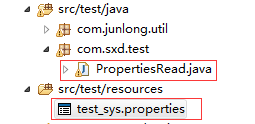关于资源文件的读取,有很多种方法,下面补充了多种方法
使用java自带的util包下的ResourceBundle类获取,使用方法最简单
//获取资源文件中键值对 ResourceBundle bundle = ResourceBundle.getBundle("资源文件的名字,不带后缀"); bundle.getString("键名");
注意点:①资源文件直接放在项目的src下,也就是你项目的classpath下,编译完放置的路径在classes下


②注意 ResourceBundle bundle = ResourceBundle.getBundle("quest");这里就填写你资源文件的名字,不用写后缀
③注意 maven管理的项目下,就将配置文件放置在resources文件夹下,编译后的位置就在classes文件夹下

----------------------------------------------------------------------------第二种方法-------------------------------------------------------------------------
2.第二种方法,java.util.Properties获取资源对象
不会因为上面的getString或者getObjec获取不存在的key的时候,会报错的情况


import java.io.IOException; import java.util.Properties; import org.junit.Test; import org.springframework.core.io.ClassPathResource; import org.springframework.core.io.Resource; public class PropertiesRead { @Test public void testF(){ Properties properties = new Properties(); Resource resource =new ClassPathResource("test_sys.properties"); try { properties.load(resource.getInputStream()); System.out.println(properties.get("1.4")); } catch (IOException e) { System.out.println("异常如下:"+ e); } } }
结果:
 不会因为找不到key而报错。
不会因为找不到key而报错。
-----------------------------------------------------------------------第三种方法----------------------------------------------------------------------------
3.使用Java自带方式获取文件,区别与第二种方法使用spring工具类获取文件路径、
首先,先看一下怎么能拿到本项目中的资源文件
 资源文件内容:
资源文件内容:
@org.junit.Test public void test() throws IOException{ System.out.println(this.getClass().getClassLoader().getResource(".").getPath()); }

可以看到 ,使用上面的方法,可以获取到如上的路径,
target是项目编译完之后的编译文件存放的地方,可以在上面的路径下看到咱们想要的资源文件。

可以看到,项目编译完后,编译文件存在的路径是下面
 分别对应
分别对应 classes对应main资源包,test-classes对应test资源包
classes对应main资源包,test-classes对应test资源包
也就是说,通过上面的方法,就可以获取到每一个模块的跟路径,
那这样就仅使用java自带的方法,获取到项目中的资源文件了。
代码如下:获取资源文件中存在的键
@org.junit.Test public void test() throws IOException{ FileInputStream fileInputStream = new FileInputStream(this.getClass().getClassLoader().getResource(".").getPath()+"sys_product_price.properties"); Properties properties = new Properties(); properties.load(fileInputStream); System.out.println(properties.get("1-90")); }

代码如下:获取不存在的键
@org.junit.Test public void test() throws IOException{ FileInputStream fileInputStream = new FileInputStream(this.getClass().getClassLoader().getResource(".").getPath()+"sys_product_price.properties"); Properties properties = new Properties(); properties.load(fileInputStream); System.out.println(properties.get("不存在的键")); }

---------------------------------------------------------------------------问题----------------------------------------------------------------------------------
【问题】
问题1:在解析资源文件的过程中,

解决方法:
这是因为在本项目的目录下并没有找到本资源文件,把资源文件放到上面展示的位置即可。
-----------------------------------------------------------------------------分割----------------------------------------------------------------------
问题2:
报错如下:
java.util.MissingResourceException: Can't find resource for bundle java.util.PropertyResourceBundle, key 1.4



@Test public void testF(){ ResourceBundle bundle = ResourceBundle.getBundle("test_sys"); System.out.println(bundle.getString("1.4")); }
@Test public void testF(){ ResourceBundle bundle = ResourceBundle.getBundle("test_sys"); System.out.println(bundle.getObject("1.4").toString()); }
不论是getString(键名)还是getObject(键名),如果找不到键名,都不会返回Null,而是会报错。
问题原因:
找不到键名“1.4”.

解决方法:
@Test public void testF(){ ResourceBundle bundle = ResourceBundle.getBundle("test_sys"); try { System.out.println(bundle.getString("1.4")); } catch (MissingResourceException e) { System.out.println("捕捉异常,自行处理,不至于程序报错"); } }
或者,使用文章开头的 第二种Properties方式。
------------------------------------------------------------------分割--------------------------------------------------------------------